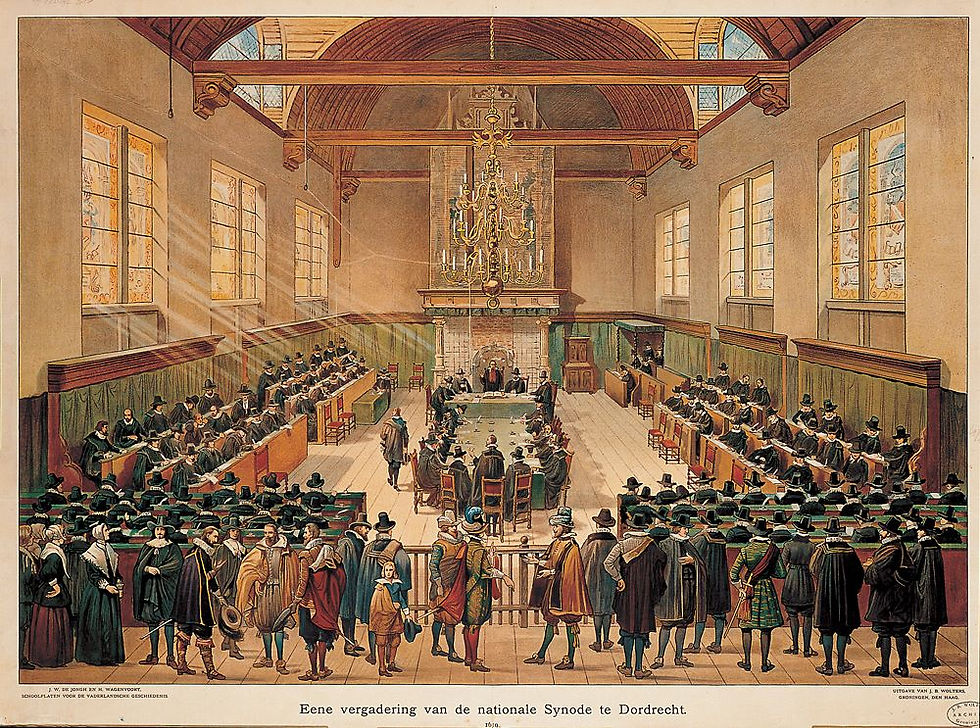A History of the Synod of Dort
- Vic Bernales
- Oct 6, 2022
- 4 min read

I have friends in the Philippines who are familiar with the Five Points of Calvinism or commonly known as TULIP. Some of them, however, do not know that these five points of Christian doctrine are based on a document, in fact a confession of faith, written by a church synod in the Netherlands in early 17th century.
This confessional document is called the Canons of Dort. Do you wonder how this confessional statement came about? Do you want to know why some Reformed churches include this as part of their written doctrinal standards?
Here is what I have gathered from history books and lectures on the Dutch Reformed church history regarding the background of this important Reformed doctrinal confession of faith.
Under the leadership of William of Orange (also known as William the Silent, 1533-1584), the Netherlands was able to break from the Hispanic Roman Catholic domination. This was also the period when Spain was starting to colonize the islands of the Philippines.
The Reformed faith, which emerged from early 16th century continental Europe, particularly in Switzerland, Germany, and France, flourished in the Netherlands and was embraced by William in 1573.
Then in 1575, William established the University of Leiden. This was ten years after the explorer, and later governor, Miguel Lopez de Legazpi landed in Cebu island (in central Philippines) and made settlements there, naming them "Villa del Santisimo Nombre de Jesus" (Town of the Most Holy Name of Jesus).
William, however, was assassinated in 1584. This made the Netherlands temporarily under the governorship of Leicester, representing Elizabeth I of England.
At that time the Reformed church in the Dutch country was flourishing. However, there was a looming controversy within the church that originated from one of the theology professors in the University of Leiden. Eventually the controversy was addressed by the state through the calling of an international Reformed synod.
Prior to the Synod of Dort in 1618-1619, the Reformed church in the Netherlands has experienced some high points. In 1561, the Belgic Confession was written by Guido de Bres. This confession of faith was adopted by the Reformed church in the Netherlands.
In 1563, another significant doctrinal formulation was written and was eventually adopted in the Dutch Church by the Synod of Wesel in 1568. This doctrinal formulation known as the Heidelberg Catechism was written primarily by Zacharias Ursinus, a young theology professor at the university at Heidelberg, and was helped by another young minister at the university, Caspar Olevianus. The Heidelberg Catechism became a significant expression of Calvinistic Reformed church in the Netherlands.
In early 1600, a theology professor at the University of Leiden named Jacobus (James) Arminius started to teach a different kind of theology that does not comport with the Belgic Confession and the Heidelberg Catechism. Arminius, who studied under Theodore Beza in Geneva, became popular to some merchant class and civil governors, as well as to his students at Leiden. He promoted a moderate kind of Calvinism.
As a result he was in conflict with his colleagues at the university, particularly with Franciscus Gomarus (1563-1641), who attacked Arminius's "foreknowledge" view of predestination, which states that God chose people to save based on their foreseen response to gospel preaching.
So Arminius called for a synod that would resolve the conflict and grant his wish to revise the Belgic Confession and the Heidelberg Catechism. Arminius died, however, in 1609 and so his students pursued his cause. His students were called the Remonstrants.
These tenacious students of Arminius wanted a national synod that would revise the Calvinistic Belgic Confession and Heidelberg Catechism claiming that there are errors, at least, at five critical points of doctrine in these confessions.
This led to the gathering of sixty-two (62) Reformed pastors, elders, and theology professors from the Netherlands, and twenty-four (24) delegates representing the Reformed churches from Germany, Switzerland, Scotland, and England. Representatives from the Reformed churches in France were invited but were not able to attend this gathering known as the Synod of Dort in the city of Dordrecht.
There were thirteen (13) Remonstrants who came before the synod and tried to disrupt the proceedings with their insistence that their doctrinal positions were Biblical. The synod dismissed them and their views were rejected.
The Synod of Dort answered the five points of doctrine which the Remonstrants raised against Calvinism. The assembly affirmed and declared that God's predestination is based on His good pleasure (U), that Christ's atonement was particular and definite (L), that man is depraved and unable to save himself (T), that God's grace is irresistible (I), and that the believer will persevere to the end by the preserving grace of God (P).
These responses are written in the document produced by the synod called the Canons of Dort. It contains five heads of doctrine. These heads of doctrine are (1) divine election and reprobation, (2) the death of Christ and the redemption of men thereby, (3) the corruption of man, (4) his conversion to God and the manner thereof, and (5) the perseverance of the saints.
The synod also wrote a church order for the Dutch Reformed church. It also affirmed the truths contained and confessed in the Belgic Confession and the Heidelberg Catechism.
Thus the synod produced a very important doctrinal formulation in the Canons of Dort, which together with the Belgic Confession and the Heidelberg Catechism form the doctrinal standards of the Reformed churches all over the world known as the Three Forms of Unity (TFU).
Posted with permission from Ptr Vic Bernales, Pastor, Davao Covenant Reformed Church
Original from a Facebook post here.
Yorumlar